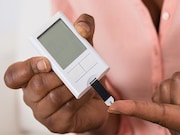Sweden’s lower HbA1c target values not linked to further organ protection
TUESDAY, Oct. 8, 2019 (HealthDay News) — A glycated hemoglobin (HbA1c) target value of <6.5 percent does not offer additional protection against organ complications for patients with type 1 diabetes compared with a target of 6.5 to 6.9 percent, according to a study recently published in The BMJ.
Marcus Lind, M.D., Ph.D., of the University of Gothenburg in Sweden, and colleagues assessed 10,398 children and adults with type 1 diabetes who were recorded in the Swedish National Diabetes Registry during 1998 to 2017. Patients were followed from first observation until the first incidence of retinopathy or nephropathy, the last follow-up, or the end of data collection on Dec. 31, 2017.
The researchers observed no additional reduction in the risk for retinopathy and nephropathy for HbA1c levels of <6.5 percent. However, the lower HbA1c target increased risk for severe hypoglycemia compared with 6.5 to 6.9 percent (relative risk, 1.34). At HbA1c levels of 7.0 to 7.4 percent, there was an increased risk for any retinopathy (odds ratio, 1.31) and microalbuminuria (odds ratio, 1.55). At HbA1c levels of >8.6 percent, there was a higher risk for proliferative retinopathy (odds ratio, 5.98) and macroalbuminuria (odds ratio, 3.43).
“The current findings support a general target of HbA1c <7.0 percent in people with type 1 diabetes," the authors write. "People who achieve HbA1c levels <6.5 percent should be vigilant about not spending too much time in hypoglycemia and achieve a good diabetes-related quality of life."
One author disclosed financial ties to the pharmaceutical industry.
Copyright © 2019 HealthDay. All rights reserved.








